
Harmonizing the Old and New: The Dynamics of Radio Advertising in the Digital Era
Among the many advertising options available top marketers, radio ads continue to play a significant role in shaping brand narratives and reaching audiences. However, the rise of internet radio has introduced a new dimension to the audio advertising space, leading to a dynamic interplay between traditional and digital mediums. In fact, audio advertising was recently ranked the fastest growth of any media! As a marketer, understanding the nuances of both platforms can empower you to craft strategies that resonate with the digital generation.
The Enduring Charm of Traditional Radio Ads
Despite the digital revolution, traditional radio has not lost its allure. Here’s why:
- Vast Reach: Traditional radio boasts an expansive reach with thousands of stations nationwide, engaging a diverse listener base across age groups, professions, and cultural backgrounds, making it an essential tool for local businesses to impact their communities.
- Engagement: Radio uniquely integrates into daily routines, serving as a companion during commutes, chores, or work, fostering an environment where listeners are more receptive to ads, leading to higher content retention due to the need for active listening.
- Cost-Effectiveness: Producing radio ads is less resource-intensive compared to visual media, requiring only a well-crafted script, quality voice talent, and optional sound effects, offering an affordable advertising avenue for small to medium-sized businesses to reach a broad audience without straining their marketing budgets.
However, traditional radio is not without its limitations. Measuring the impact and engagement of radio ads can be challenging, and the medium offers limited targeting options compared to digital platforms. There is no doubt that other forms of marketing, including all the effective types of inbound and outbound marketing, should still be included in your overall strategy.
The Rise of Internet Radio Ads

Internet radio and podcasts have ushered in a new era for audio advertising. Here’s what sets them apart:
- Precision Targeting: Leverage advanced targeting on digital platforms to connect ads with specific user segments, based on their interests, behaviors, and demographics, enhancing ad relevance and effectiveness.
- Interactive Elements: Utilize interactive elements in internet radio ads, such as clickable links, to actively engage listeners and guide them directly to websites or promotional content, fostering immediate action.
- Analytics and Measurement: Benefit from the detailed analytics provided by digital platforms, enabling real-time tracking of ad performance and listener engagement, facilitating data-driven decision-making and strategy optimization.
While internet radio ads offer numerous advantages, they also come with challenges, such as increased competition and the need for more sophisticated production techniques to capture the audience’s attention.
Balancing Traditional and Internet Radio Ads
So, which is better for the digital generation? The answer lies in a balanced approach. Consider the following factors to harmonize traditional and internet radio advertising:
- Understand Your Audience: To effectively engage your audience, it’s crucial to delve deep into their preferences, lifestyles, and listening habits. This insight will guide you in striking the right balance between traditional and internet radio advertising, ensuring your message is heard by the right ears. By tailoring your approach to match audience behavior, you can maximize the impact and relevance of your ads, leading to greater connection and response.
- Leverage Strengths of Each Medium: Traditional radio, with its widespread accessibility, is ideal for achieving broad exposure and fostering a sense of community among local listeners. On the other hand, internet radio offers the advantage of precise targeting and the inclusion of interactive elements, such as clickable ads, that can drive direct engagement and conversions. By playing to the strengths of each medium, you can craft a comprehensive advertising strategy that covers both wide-reaching brand awareness and focused, actionable campaigns.
- Integrate with Other Channels: For a truly effective marketing campaign, radio advertising should not stand alone but be a part of a larger, multi-channel strategy. This means ensuring that your radio ads—both traditional and internet-based—align with and support your efforts across digital, print, and social media platforms. Cohesion across channels not only amplifies your message but also reinforces your brand identity, creating a seamless experience for your audience no matter where they encounter your brand.
Crafting Effective Radio Ads for the Digital Era
Creating compelling radio ads that resonate with the digital generation requires creativity and strategic planning. Keep these tips in mind:

- Craft a Clear Message: The effectiveness of your ad hinges on its ability to communicate a clear and concise message that strikes a chord with your target audience. It should distill your brand’s essence and value proposition into a compelling narrative that captures attention and fosters understanding. Crafting such a message requires insight into your audience’s needs and preferences, ensuring that every word resonates and leaves a lasting impression.
- Incorporate a Strong Call-to-Action: A compelling radio ad doesn’t just inform; it motivates the listener to take immediate action. Whether it’s visiting a website, taking advantage of a promotion, or connecting with your brand on social media, your call-to-action (CTA) should be irresistible and clear. An effective CTA transforms passive listeners into active participants, bridging the gap between hearing an ad and engaging with your brand. It can help close prospective customers at varying stages of the lead nurturing journey.
- Ensure Audio Quality: In the realm of radio and internet broadcasts, audio quality cannot be compromised. High-quality production, including clear voiceovers, balanced sound levels, and crisp sound effects, is essential to convey professionalism and capture the listener’s trust. Especially in internet radio, where expectations for content quality are high, investing in superior audio production can significantly enhance the listener’s experience and your ad’s impact.
- Test and Optimize: The landscape of radio advertising is dynamic, necessitating ongoing experimentation with various ad formats, messages, and placement strategies. By continuously testing how different elements perform with your target audience, you can glean valuable insights into what resonates most effectively. This iterative process allows for the fine-tuning of your campaigns, ensuring that your advertising efforts are always aligned with your objectives and yielding optimal results.
For more insights on crafting effective advertising strategies, explore the wealth of knowledge on Stevens & Tate’s articles. You’ll find valuable information on marketing trends, strategies, and best practices that can enhance your advertising efforts.
What is the brand development process? Read more here.
Finding Harmony
The choice between traditional and internet radio ads is not binary but rather a strategic blend that maximizes the strengths of each medium and optimizes your advertising budget. By understanding your audience, leveraging the unique advantages of traditional and digital platforms, and continuously refining your approach, you can create radio advertising campaigns that effectively engage the digital generation.
Embracing the harmonious interplay between traditional and internet radio ads will not only enhance your brand’s reach but also ensure a deeper connection with the diverse, digitally-savvy audience of today.







